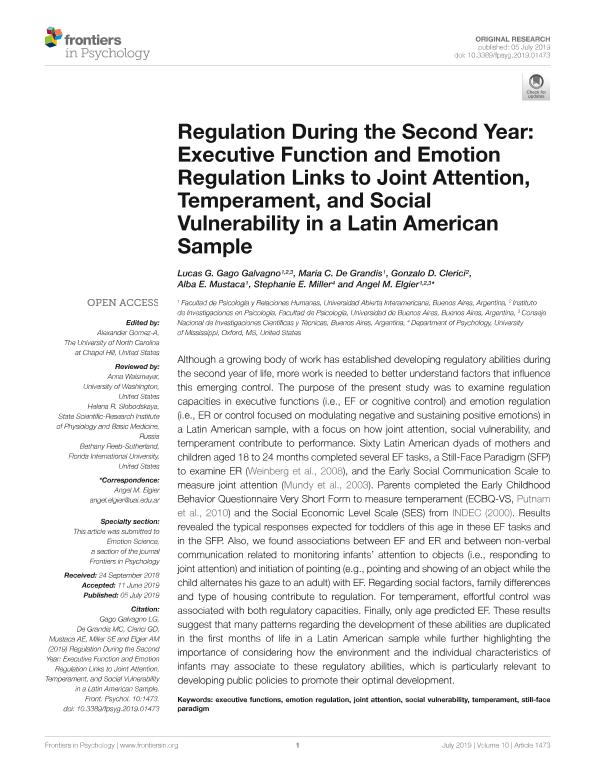Mostrar el registro sencillo del ítem
dc.contributor.author
Gago Galvagno, Lucas Gustavo

dc.contributor.author
de Grandis, María Carolina

dc.contributor.author
Clerici, Gonzalo Daniel

dc.contributor.author
Mustaca, Alba E.
dc.contributor.author
Miller, Stephanie Elisabeth

dc.contributor.author
Elgier, Angel Manuel

dc.date.available
2021-04-29T13:38:00Z
dc.date.issued
2019-07-05
dc.identifier.citation
Gago Galvagno, Lucas Gustavo; de Grandis, María Carolina; Clerici, Gonzalo Daniel; Mustaca, Alba E.; Miller, Stephanie Elisabeth; et al.; Regulation during the second year: Executive function and emotion regulation links to joint attention, temperament, and social vulnerability in a Latin American sample; Frontiers Media S.A.; Frontiers in Psychology; 10; 1473; 5-7-2019; 1-13
dc.identifier.issn
1664-1078
dc.identifier.uri
http://hdl.handle.net/11336/131013
dc.description.abstract
Although a growing body of work has established developing regulatory abilities during the second year of life, more work is needed to better understand factors that influence this emerging control. The purpose of the present study was to examine regulation capacities in executive functions (i.e., EF or cognitive control) and emotion regulation (i.e., ER or control focused on modulating negative and sustaining positive emotions) in a Latin American sample, with a focus on how joint attention, social vulnerability, and temperament contribute to performance. Sixty Latin American dyads of mothers and children aged 18 to 24 months completed several EF tasks, a Still-Face Paradigm (SFP) to examine ER (Weinberg et al., 2008), and the Early Social Communication Scale to measure joint attention (Mundy et al., 2003). Parents completed the Early Childhood Behavior Questionnaire Very Short Form to measure temperament (ECBQ-VS, Putnam et al., 2010) and the Social Economic Level Scale (SES) from INDEC (2000). Results revealed the typical responses expected for toddlers of this age in these EF tasks and in the SFP. Also, we found associations between EF and ER and between non-verbal communication related to monitoring infants' attention to objects (i.e., responding to joint attention) and initiation of pointing (e.g., pointing and showing of an object while the child alternates his gaze to an adult) with EF. Regarding social factors, family differences and type of housing contribute to regulation. For temperament, effortful control was associated with both regulatory capacities. Finally, only age predicted EF. These results suggest that many patterns regarding the development of these abilities are duplicated in the first months of life in a Latin American sample while further highlighting the importance of considering how the environment and the individual characteristics of infants may associate to these regulatory abilities, which is particularly relevant to developing public policies to promote their optimal development.
dc.format
application/pdf
dc.language.iso
eng
dc.publisher
Frontiers Media S.A.

dc.rights
info:eu-repo/semantics/openAccess
dc.rights.uri
https://creativecommons.org/licenses/by/2.5/ar/
dc.subject
EMOTION REGULATION
dc.subject
EXECUTIVE FUNCTIONS
dc.subject
JOINT ATTENTION
dc.subject
SOCIAL VULNERABILITY
dc.subject
STILL-FACE PARADIGM
dc.subject
TEMPERAMENT
dc.subject.classification
Otras Psicología

dc.subject.classification
Psicología

dc.subject.classification
CIENCIAS SOCIALES

dc.title
Regulation during the second year: Executive function and emotion regulation links to joint attention, temperament, and social vulnerability in a Latin American sample
dc.type
info:eu-repo/semantics/article
dc.type
info:ar-repo/semantics/artículo
dc.type
info:eu-repo/semantics/publishedVersion
dc.date.updated
2021-04-22T20:10:47Z
dc.journal.volume
10
dc.journal.number
1473
dc.journal.pagination
1-13
dc.journal.pais
Suiza

dc.description.fil
Fil: Gago Galvagno, Lucas Gustavo. Universidad Abierta Interamericana. Facultad de Psicología; Argentina. Universidad de Buenos Aires. Facultad de Psicología. Instituto de Investigaciones; Argentina. Consejo Nacional de Investigaciones Científicas y Técnicas; Argentina
dc.description.fil
Fil: de Grandis, María Carolina. Universidad Abierta Interamericana. Facultad de Psicología; Argentina. Consejo Nacional de Investigaciones Científicas y Técnicas; Argentina
dc.description.fil
Fil: Clerici, Gonzalo Daniel. Universidad de Buenos Aires. Facultad de Psicología. Instituto de Investigaciones; Argentina
dc.description.fil
Fil: Mustaca, Alba E.. Universidad Abierta Interamericana. Facultad de Psicología; Argentina
dc.description.fil
Fil: Miller, Stephanie Elisabeth. University of Mississippi; Estados Unidos
dc.description.fil
Fil: Elgier, Angel Manuel. Universidad Abierta Interamericana. Facultad de Psicología; Argentina. Universidad de Buenos Aires. Facultad de Psicología. Instituto de Investigaciones; Argentina. Consejo Nacional de Investigaciones Científicas y Técnicas; Argentina
dc.journal.title
Frontiers in Psychology
dc.relation.alternativeid
info:eu-repo/semantics/altIdentifier/doi/https://doi.org/10.3389/fpsyg.2019.01473
dc.relation.alternativeid
info:eu-repo/semantics/altIdentifier/url/https://www.frontiersin.org/articles/10.3389/fpsyg.2019.01473/abstract
Archivos asociados
